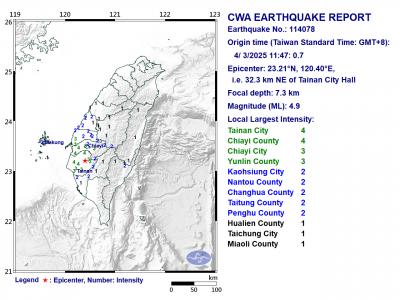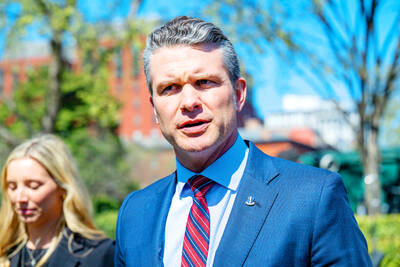Her eyes lit bright with concentration, Taiwanese linguist Sung Li-may (宋麗梅) leans in expectantly as one of the planet’s last 10 speakers of the Kanakanavu language shares his hopes for the future.
“I am already very old,” says 80-year-old Mu’u Ka’angena, a leathery-faced man with a tough, sinewy body and deeply veined hands.
A light rain falls onto the thatched roof of the communal bamboo hut, and smoke from a dying fire drifts lazily up the walls, wafting over deer antlers, boar jawbones and ceremonial swords that decorate the interior like trophies from a forgotten time.
“Every day I think: Can our language be passed down to the next generation? It is the deepest wish in my heart that it can be,” he says.
Kanakanavu, Sung says, has a lot more going for it than just its intrinsic value. It belongs to the same language family that experts believe spread from Taiwan 4,000 years ago, giving birth to languages spoken today by 400 million people in an arc extending from Easter Island off South America to Madagascar, off Africa.
“Taiwan is where it all starts,” says archeologist Peter Bellwood, who with linguist Robert Blust developed the now widely accepted theory that people from Taiwan leveraged superior navigation skills to spread their Austronesian language far and wide. At least four of Taiwan’s 14 government-recognized Aboriginal languages are still spoken by thousands of people, but a race is on to save the others from extinction.
The youngest good speaker of Kanakanavu, also known as Southern Tsou, is 60, and the next-youngest, 73.
“To survive a language has to be spoken,” Sung said. “And with this one it isn’t happening.”
It’s a story repeated in the remote corners of the earth, as younger generations look to the dominant language for economic survival and advancement, whether it be English or, in Taiwan’s case, Mandarin.
Aborigines account for only 2 percent of the Taiwanese population of 23 million. Many young people are leaving Dakanua, a picturesque village in the south that is home to the Kanakanavu language, to work in the cities.
Sung is clearly revered by Dakanua’s tiny cadre of Kanakanavu speakers, who are happy to spend long hours going over their language with her and a small group of graduate students she brings to the village from National Taiwan University in Taipei.
On a recent Saturday afternoon, they sat outside a well-ordered cluster of whitewashed concrete buildings, painstakingly documenting the proper use of the imperative and the grammatical subtleties of concepts like “it could be that” or “it is possible that.”
In the background the bamboo and palm tree covered contours of Mount Anguana protruded through a moving blanket of fog and mist, and a thin rain fell in the Nanzihsian River (楠梓仙溪) valley below.
Life here is defined by farming, a reverent belief in Christianity — Presbyterian and Roman Catholic missionaries converted almost two-thirds of the Aboriginal population in the 1930s and 1940s — and chronic concern about the harsh elements. Five hundred residents in the nearby Siaolin Village (小林) were buried alive three-and-a-half years ago when torrential rains unleashed by a typhoon sent thousands of tonnes of mud cascading down onto their homes.
Sung started working with Aboriginal languages almost by accident. After returning to Taiwan in 1994 as a newly minted doctor of linguistics from the University of Illinois, her department head at National Taiwan University pushed her into the discipline, insisting that Taiwan’s majority Chinese population had to understand more about its Aboriginal minority.
“At first I was intimidated,” says Sung, now the director of the university’s Graduate Institute of Linguistics, one of a handful of Taiwanese bodies seeking the preservation of the Aboriginal languages as part of a wide-ranging effort funded by the government.
“I had no idea of how to carry out my field work among the Aboriginals. But over time I got used to it. And I learned the importance of Taiwanese Aboriginal languages in the overall scheme of Austronesian dispersion,” she says.
The deep-rooted linguistic seeds the dispersal sowed have now morphed into dozens of languages — Malay for example, and the Philippines’ Tagalog — that make Austronesian one of the largest language groups in the world.
The dispersion is illustrated by the similarities of the words for “ear.” What linguists call the proto-form — the Taiwanese basis from thousands of years ago — is usually rendered as galinga. In modern Taiwanese Aboriginal dialects that becomes calinga, while in the Philippines it’s tenga, in Fiji dalinga, in Samoa talinga and in Papua New Guinea taringa.
Taiwanese Aborigines traveling to New Zealand, for example, are struck by the close relationship of their own languages to Maori, particularly when they hear the local version of numbers.
Sung’s most recent project was collating a Chinese-English dictionary for the Sediq language spoken by the tribe of Taiwanese mountain dwellers memorialized inWarriors of the Rainbow: Seediq Bale , a 2011 film recounting their rebellion against Japanese occupiers in the 1930s.
In February last year she began her work with Kanakanavu, hoping she can preserve the language before the last speakers die out. The odds against her are long. Even many 40 and 50-year olds are incapable of mouthing anything more than a few simple phrases in their native tongue.
Still, frolicking on the neatly cut lawn of Dakanua’s deserted bed and breakfast is a three-year-old girl with a runny nose, an infectious smile and a lovely lilt to her voice.
She is the granddaughter of Mu’u Ka’angena, the man with the leathery skin, and just within earshot she begins conversing with him in very simple Kanakanavu.
“Did you hear that?” Sung asks. “Isn’t it wonderful? She’s our hope for the future.”

A magnitude 4.9 earthquake struck off Tainan at 11:47am today, the Central Weather Administration (CWA) said. The hypocenter was 32.3km northeast of Tainan City Hall at a depth of 7.3km, CWA data showed. The intensity of the quake, which gauges the actual effect of a seismic event, measured 4 in Tainan and Chiayi County on Taiwan's seven-tier intensity scale, the data showed. The quake had an intensity of 3 in Chiayi City and County, and Yunlin County, while it was measured as 2 in Kaohsiung, Nantou County, Changhua County, Taitung County and offshore Penghu County, the data showed. There were no immediate reports of

‘DENIAL DEFENSE’: The US would increase its military presence with uncrewed ships, and submarines, while boosting defense in the Indo-Pacific, a Pete Hegseth memo said The US is reorienting its military strategy to focus primarily on deterring a potential Chinese invasion of Taiwan, a memo signed by US Secretary of Defense Pete Hegseth showed. The memo also called on Taiwan to increase its defense spending. The document, known as the “Interim National Defense Strategic Guidance,” was distributed this month and detailed the national defense plans of US President Donald Trump’s administration, an article in the Washington Post said on Saturday. It outlines how the US can prepare for a potential war with China and defend itself from threats in the “near abroad,” including Greenland and the Panama

The Chinese Nationalist Party (KMT) is maintaining close ties with Beijing, the Democratic Progressive Party (DPP) said yesterday, hours after a new round of Chinese military drills in the Taiwan Strait began. Political parties in a democracy have a responsibility to be loyal to the nation and defend its sovereignty, DPP spokesman Justin Wu (吳崢) told a news conference in Taipei. His comments came hours after Beijing announced via Chinese state media that the Chinese People’s Liberation Army’s Eastern Theater Command was holding large-scale drills simulating a multi-pronged attack on Taiwan. Contrary to the KMT’s claims that it is staunchly anti-communist, KMT Deputy

RESPONSE: The government would investigate incidents of Taiwanese entertainers in China promoting CCP propaganda online in contravention of the law, the source said Taiwanese entertainers living in China who are found to have contravened cross-strait regulations or collaborated with the Chinese Communist Party (CCP) could be subject to fines, a source said on Sunday. Several Taiwanese entertainers have posted on the social media platform Sina Weibo saying that Taiwan “must be returned” to China, and sharing news articles from Chinese state media. In response, the Mainland Affairs Council (MAC) has asked the Ministry of Culture to investigate whether the entertainers had contravened any laws, and asked for them to be questioned upon their return to Taiwan, an official familiar with the matter said. To curb repeated